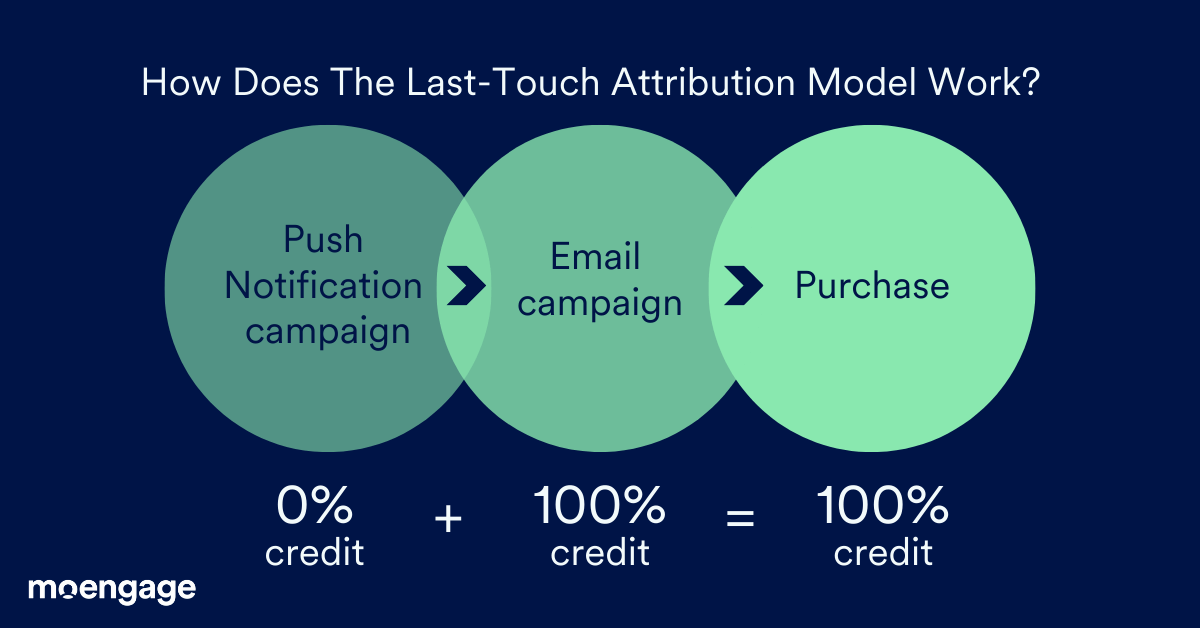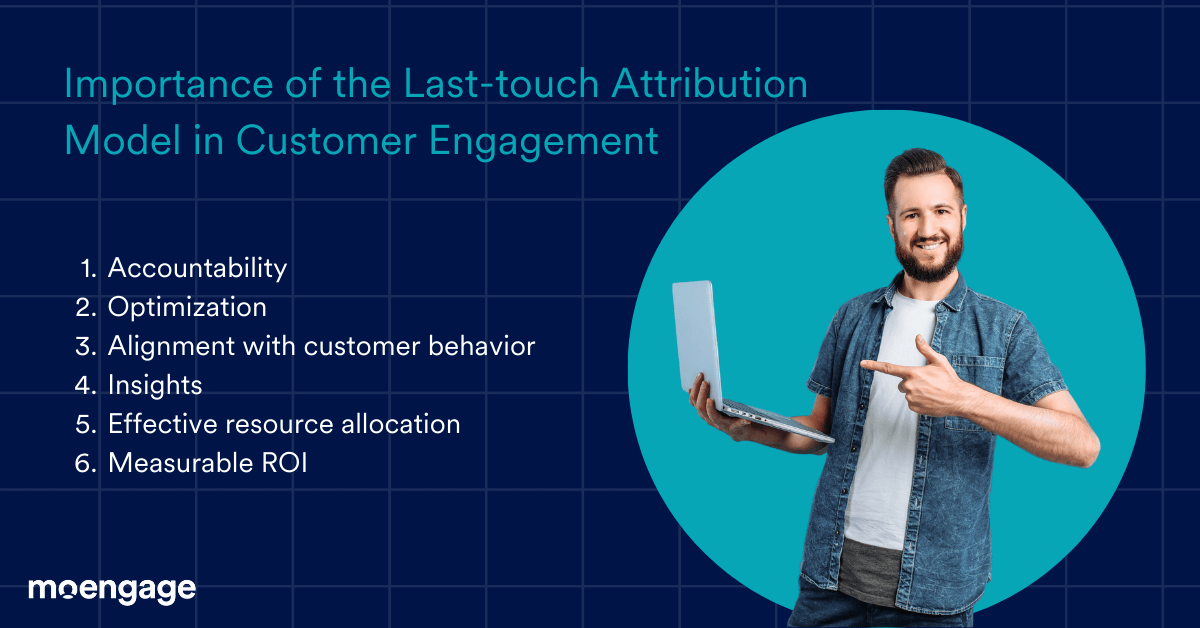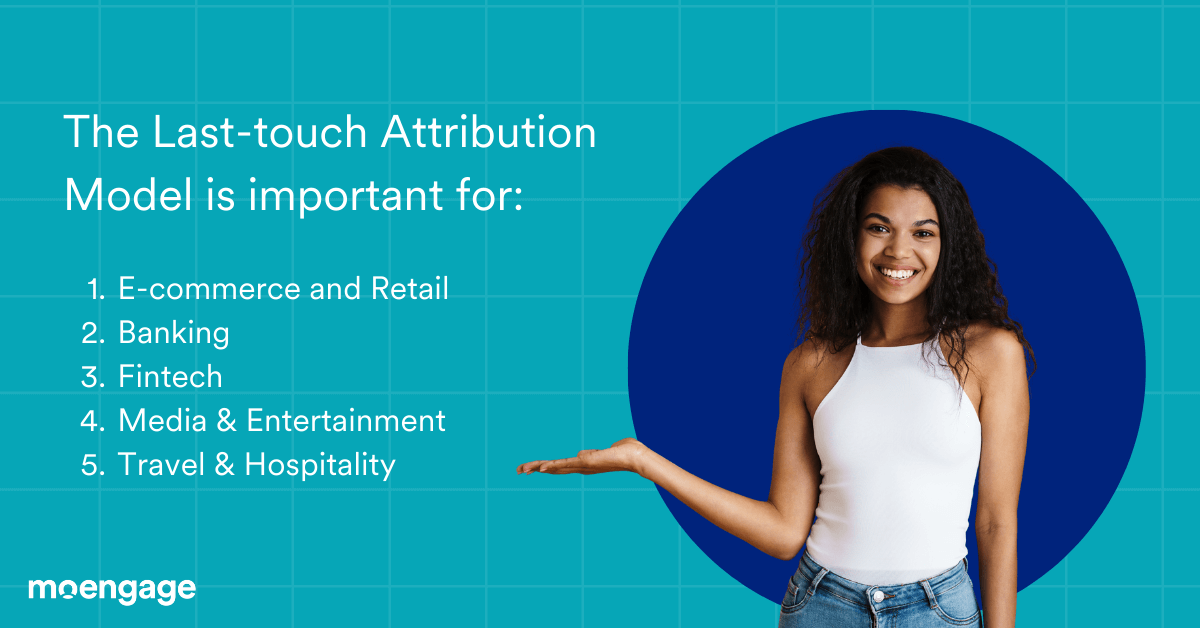A Guide To The Importance of Last-Touch Attribution Model in Customer Engagement
Learn everything you need to know about the Last-Touch Attribution Model and how to use it to gather valuable insights about customers and campaign effectiveness.

Reading Time: 7 minutes
The topic of attribution has always led to long debates in marketing and Customer Engagement circles. We’ve seen the introduction and evolution of several attribution models, such as First Interaction, Last-Touch, Linear, Time-Decay, Position-Based, and many more.
Among these, the Last-Touch Attribution model has emerged as a valuable tool to measure the effectiveness of your Customer Engagement strategies and campaigns.
In this article, you will learn the significance of the Last-Touch Attribution model, specifically within the framework of Customer Engagement. You will also understand how to leverage this model for different types of campaigns and see use cases from multiple industries.
Let’s start with the definition.
What Is The Last-Touch Attribution Model?
The Last-Touch Attribution model is an analytical model used to measure the effectiveness of your Customer Engagement campaigns.
In this model, 100% of the weightage for conversions is attributed to the final touchpoint or the latest interaction your customer took before the desired action, such as a purchase or a sign-up.
The model’s simplicity and ease of understanding make it a popular choice for assessing your Customer Engagement efforts.
Introducing the Last Interaction Model by MoEngageWhen your paid advertisements and campaigns are designed to attract customers at the moment of purchase or when your business is primarily transactional with a sales cycle that does not involve a consideration phase, the Last Interaction model is what you’re looking for! How does the Last Interaction model by MoEngage work?MoEngage’s Last Interaction model assigns 100% attribution to the latest campaign your customer has interacted with before performing the conversion action. Your customers can interact with your campaigns in two ways – by clicking and by viewing. Between these 2 interactions, MoEngage prioritizes the “click” action over the “view” action since it shows a higher intent from your customers. Let’s understand this by taking an example. Assume your goal is to drive repeat purchases for your E-commerce brand during an upcoming Halloween sale. To achieve this goal, you decide to run 2 campaigns – one Email campaign (C1), and a second Push Notification campaign (c2) sent to customers who have made a purchase on your mobile app in the last six months. Here’s how the Last Interaction model will attribute conversions under multiple potential journeys your customers can take:
 MoEngage’s Last Interaction model can be used on any campaign type – Push Notification, SMS, Email, WhatsApp, Cards, Facebook Audience Network, Google Ad Network, or more – to understand what motivates your customers to take the actions you desire them to. The Last Interaction model can also be used on any of your MoEngage Flow campaigns to better understand the highest converting touchpoints from your engagement campaigns. If you’re an existing MoEngage customer, you can reach out to your favorite Account Manager to learn more. If you’re new to MoEngage, you can schedule a demo with our product experts here! |
Why Is The Last-Touch Attribution Model Important?
If you want a more comprehensive understanding of customer journeys and campaign performance on your website or mobile app, the Last-Touch Attribution model is your most reliable friend!

Here’s why:
1. Accountability
In a world where marketing budgets are often limited, learning the right avenues to invest resources is an invaluable insight.
One of the primary reasons why marketers like yourself rely on Last-Touch Attribution is clear accountability. The model assigns 100% of the credit for a conversion to the last touchpoint, leaving no room for confusion, which empowers you to easily identify and prioritize the most effective channels or interactions that directly contribute to Customer Engagement and conversion.
2. Optimization
Last-Touch Attribution aids in optimizing your Customer Engagement campaigns by shedding light on the touchpoints that are most likely to prompt customers to take action.
You can fine-tune your strategies by understanding which interaction was the final nudge that led to your customer taking the desired action. You can then use this insight to invest more in particular channels that consistently perform well as last touchpoints, ensuring that resources are allocated where they can make the most impact.
3. Alignment with customer behavior
This model resonates with customer behavior in today’s fast-paced digital landscape.
The modern consumer navigates complex journeys, interacting with various touchpoints before making a purchasing decision. You can use Last-Touch Attribution to capture the impact of recency and relevance of your campaigns.
Customers often tend to be swayed by the latest piece of information or the most recent interaction with your brand that is still fresh in their minds.
4. Insights
Using Last-Touch Attribution to measure Customer Engagement campaigns, you can gain valuable insights into your customers’ decision-making processes.
This learning extends beyond knowing which channel is most effective by giving you a deeper understanding of all the factors that drive conversions. You can learn what messaging, timing, and content resonates with your target audience in the final and crucial stages of their journey.
5. Effective resource allocation
The Last-Touch Attribution model empowers your brand to make informed decisions about resource allocation by allowing you to focus only on those channels and campaigns that consistently deliver results in terms of Customer Engagement and conversions.
6. Measurable ROI
The Last-Touch Attribution model helps you measure the return on investment (ROI) of your Customer Engagement campaigns with relative ease.
By clearly attributing conversions to specific touchpoints, you can track the performance of each marketing channel, calculate the cost associated with each interaction, and assess whether the returns justify the expenses. This transparency is instrumental for you to make data-driven decisions and refine your strategies.
Different Ways You Can Use The Last-Touch Attribution Model For Customer Engagement
1. Onboarding Campaigns
The Last-Touch Attribution model helps you identify the last interaction that motivated your customers to take their initial steps during their onboarding journey, like creating an account or downloading an app.
For example, a customer who signs up for a retail app after clicking on a referral link in an email is attributed to that email as the last touchpoint.
2. First Purchase Campaigns
In first purchase campaigns, the model will help you identify the latest touchpoint or channel responsible for the customer’s first transaction on your platform.
If a customer buys a product after clicking on a social media ad, the Last-Touch Attribution model gives the entire weightage to the ad for conversions.
3. Repeat Purchase Campaigns
Repeat purchase campaigns aim to foster customer loyalty and encourage more transactions on your website, mobile app, or physical store.
Using the Last-Touch Attribution model, you can learn which channel was the latest driver for the customer to make another purchase – whether it was an email with a special offer, a push notification, or a personalized recommendation via an in-app message.
4. Retention Campaigns
Marketers like yourself use retention campaigns to keep your existing customers engaged with your brand for a long time, even when they are not transacting.
The Last-Touch Attribution model helps identify the touchpoint that most recently influenced a customer to remain loyal or participate in loyalty programs.
5. Reactivation Campaigns
You need to run reactivation campaigns to engage dormant customers who have reduced interaction with your brand and are at risk of churning out.
By applying Last-Touch Attribution, you can determine which touchpoint or interaction successfully reignited your customer’s interest and led them to make a purchase or re-engage with the brand’s website or mobile app.
How To Use The Last-Touch Attribution Model For Your Brand

1. E-commerce and Retail
Last-Touch Attribution is crucial in the E-commerce and Retail industry for your campaigns that aim to convert potential customers into buyers. For instance, a customer who purchases a product after clicking on a social media ad receives the full attribution credit for the conversion, underscoring the impact of the last interaction.
2. Banking
You will find that Customer Engagement campaigns in the Banking vertical often involve onboarding new customers or encouraging them to open accounts. The Last-Touch Attribution model identifies the last interaction that prompted the customer to take action, such as clicking on an email to open an account.
3. Fintech
In your Fintech brand, you can use the Last-Touch Attribution model to understand which touchpoints led customers to sign up for your services. For instance, a potential customer may download your app after clicking on a sponsored link in a third-party blog post, with the Last-Touch model attributing the conversion to the blog post.
4. Media & Entertainment (OTT)
In the Media & Entertainment industry, you can double down on campaigns to attract new subscribers by identifying the last touchpoint that influenced existing customers to subscribe. For example, if a customer subscribed to your streaming service after clicking on a sponsored YouTube video ad, you know you can run more video ad campaigns on YouTube.
5. Travel & Hospitality
In the Travel & Hospitality vertical, the Last-Touch Attribution model helps you determine the most effective touchpoints for driving conversions. For example, a customer who books a flight after clicking on a Google Ad for a discounted fare receives full attribution credit for the conversion.
Conclusion
In a world of ever-changing consumer behavior, the Last-Touch Attribution model plays a pivotal role in assessing the impact of your Customer Engagement campaigns.
By identifying the last touchpoint that leads to a conversion, you gain valuable insights into the effectiveness of your strategies, irrespective of the industry your brand belongs to.
You can apply Last-Touch Attribution and learn about your customers and how they interact with your campaigns across the customer journey lifecycle – onboarding, first purchase, repeat purchase, retention, reactivation, and more!














